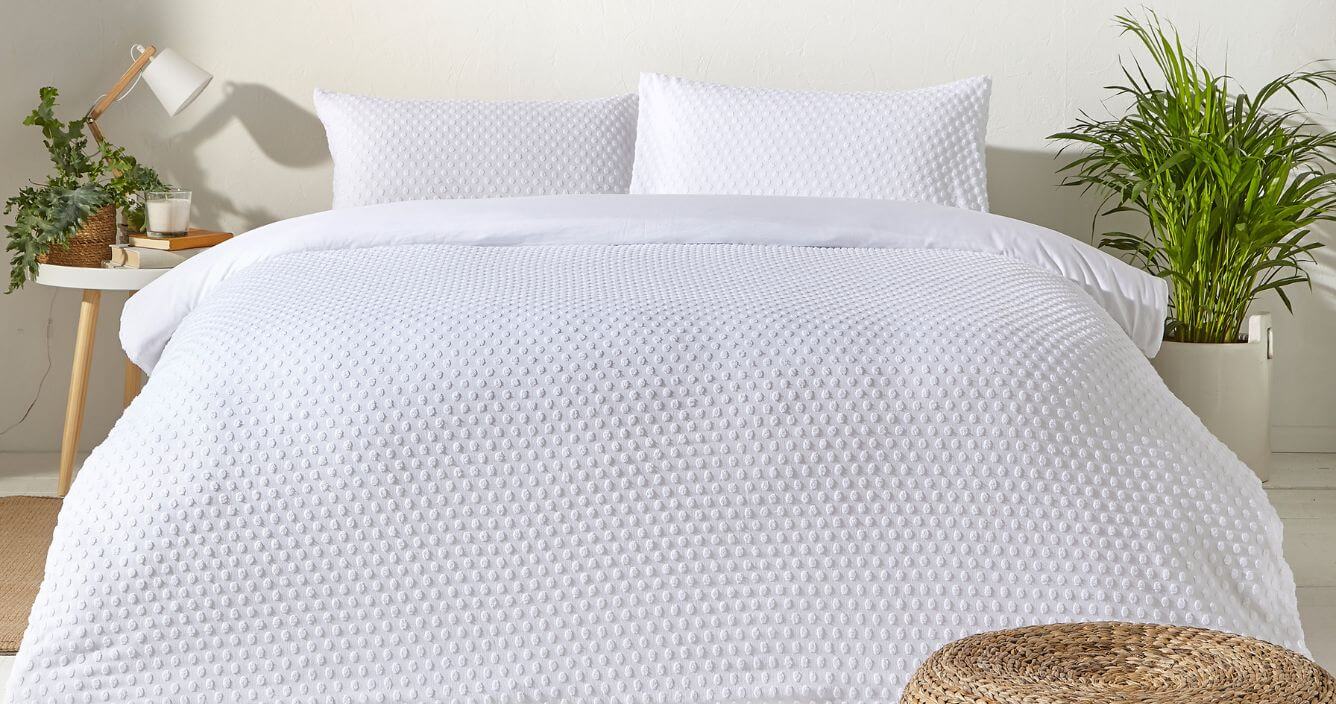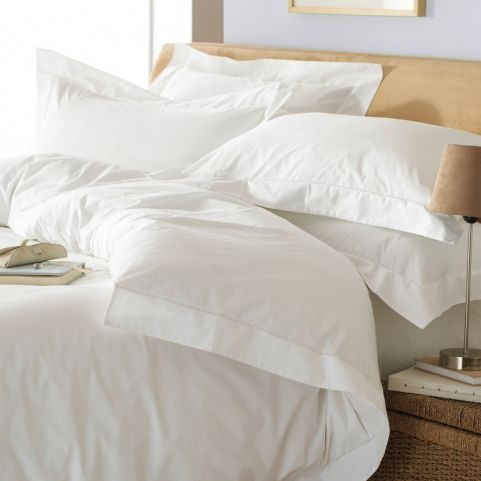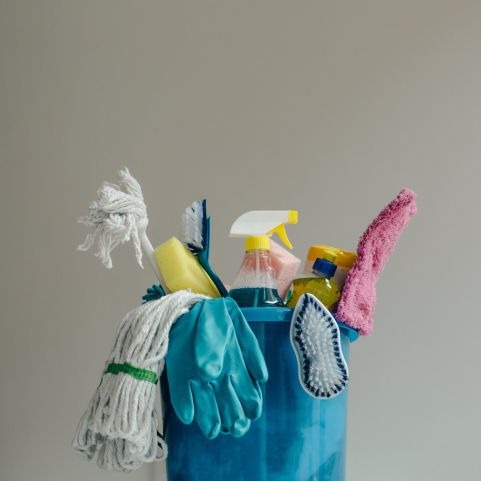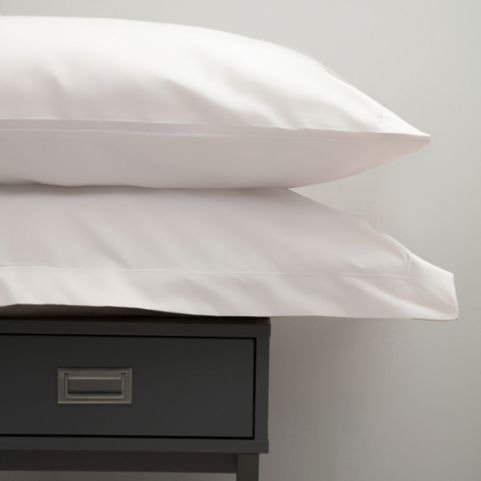is white bedding practical? – discover the secrets behind how to keep white bedding white.
If there’s one shade we’d call the shining star of the bedding world – you can bet your bottom bed sheet it would be white. From luxury hotel bedlinen to the clean, comforting sheets of hospital cots across the globe – white is the consistent bedding choice, and it’s not too hard to see why. A calming, clean and serene shade according to the leading minds in colour psychology, white is perfect for lending a soothing backdrop to your sleep sanctuary. On a physical level, white reflects light better than any other shade, creating a light, airy atmosphere that makes any bedroom feel a lot more spacious.
Yet, for all its plaudits, you’d be forgiven for thinking that white bedding should be avoided like a pearly-hued plague. A quick scroll through any interior forum or chatroom soon reveals the many burning questions; Are white bed sheets a bad idea? Do white covers turn yellow? Or, perhaps the most pressing of all – how can I get my white bedding white again? It’s enough to turn anyone off snowy sheets for life, but what if we told you it’s possible to keep those whites shining bright for many a moon to come?
It might sound obvious, but one of the biggest mistakes people make with white bedding is letting it get stained in the first place. While nobody’s perfect – and even the most fiercely protected bedding will pick up dirt eventually – most stains are completely avoidable.
"We all know how hard it can be to revitalise stained white bedding, so the golden rule is to make sure it stays spotless!" advises Suzi, Design Manager and bedding expert at furn.com. "Chocolate, tea, red wine and makeup products all create notoriously stubborn stains - so keep them well clear of your white bedding".
Spotless sheets don’t come without sacrifice, and the first thing you’ll need to forego is that beloved bedtime snack. Well, hang onto the snack itself – we’d never ask anyone to deprive themselves of a little midnight chomp – but consider indulging far away from your gleaming white sheets. The same goes for any cherished fluffy friends that might be trotting around: while they might be family, those moulted hairs and muddy paws don’t bode well for your fresh white bedding.
Lastly, do your best to remove any makeup or other skin products that might leave a mess before hitting the hay. While all this might seem like a lot of work, these are small prices to pay for saving yourself the all-too-familiar heartache of the Weird Yellow Stain.
So, you’ve banished man’s best friend, ditched the messy snacks and you’ve got a full arsenal of makeup wipes on standby – but where to go from here? Don’t worry, we’re not going to ask you to put anything else into exile, but you will need to keep a vigilant eye going forward. To uncover the secrets of how to keep white bedding white, you’re going to have to start with the basics – and that means getting your washing machine in shimmering shipshape.
"If your goal is to keep white bedding white, a well-kept washing machine is an absolute must" says Suzi. "Residue from dirty clothes and old detergent combine with a washing machine's moisture to create the ideal breeding ground for bacteria and mould - so try to deep clean every 1-3 months".
Think about it – you wouldn’t use the same bucket of murky water to mop your floor year-round, so why should your washing machine be any different? The conventional wisdom suggests you should clean your washing machine every 1-3 months, but just doing it whenever you can is a whole lot better than never doing it at all.
Deep cleaning your washing machine isn’t exactly the wildest way to spend a Saturday night, but it’s nowhere near as difficult as it sounds. A lot of modern machines even come with a drum cleaning cycle, in which case all you’ve got to do is flick a switch and return to your regularly scheduled evening. However, even if you’ve weren’t blessed with a swanky smart-washer 3000 last Christmas, cleaning out your washing machine is far from an impossible chore.
All you’ll need are some kitchen cupboard staples – bicarbonate of soda (baking soda), distilled white vinegar, and a scouring pad or microfibre cloth. Start by sprinkling a pinch of baking soda onto your damp cloth or scouring pad, then get going with a good old-fashioned scrub. Do your best to cover every square inch of the drum as you wipe, paying particular attention to those dirt-trapping nooks and crannies around the rubber seals in your machine.
Once you’ve scrubbed to satisfaction, add about 240g of dry baking soda to the empty drum. Set your washing machine to its hottest, longest cycle, and leave the blessed powers of bicarb work their magic. Bicarbonate of soda has mildly abrasive properties, meaning it’s great for cutting into any deep-set dirt, scum or limescale that’s made its home in your machine. Give the drum another wipe with a clean, damp cloth once the cycle is finished, and you’re already halfway there.
Next, grab your distilled white vinegar and measure out 120ml. Pour half of this into the detergent drawer in your machine, and pour the remaining liquid into the fabric softener compartment. Run the hottest, longest cycle once again, and grab yourself a celebratory cup of tea while you await those hard-earned results. The vinegar works as a clarifier, breaking down any stubborn residue that the baking soda might have missed. Rinse down your machine with clean water once your second cycle is finished, et voila – you’ve got a sparklingly clean washing machine that’s ready for the brightest of white bedding.
.jpg?v=1692960318237)
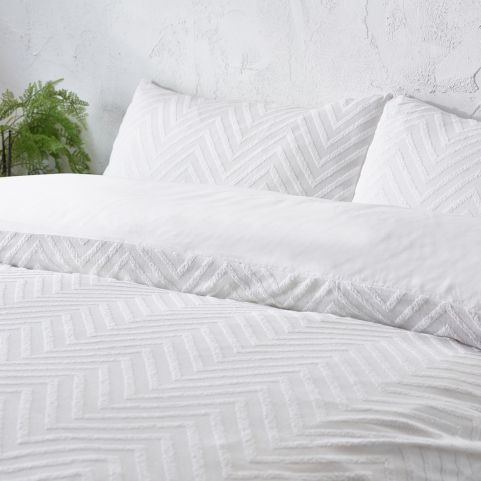
Once you’ve got your washing machine gleaming like it’s straight out of an ad for detergent pods, your white bedding is already off to a winning start. However, a good start is only half the battle, so you’ve got to keep the effort up if you want those white sheets to stay looking their best. Optimising your wash isn’t as technical as it sounds, and all it takes is a few simple steps to keep your washing machine in hue-protecting health.
You’ve heard your mum say it a million times (and surprise, surprise – she was right all along) but keeping your whites and colours separate is essential for a successful wash. One stray red sock is all it takes to leave your white bedding looking like it’s straight out of Barbie’s dreamhouse, so always double-check to make sure you’ve not got any stragglers. Use high quality washing powder and detergent that’s rich in enzymes, as these work to break up tough stains and give your whites a thorough clean.
Higher quality powders and detergents also need less heat to do their job effectively. This means you’ll run less risk of damaging the fibres in your white bedding, leaving them feeling stiff and scratchy. You won’t need to use as much of them, either, as overloading your machine with detergent or softener can cause white fabrics to develop a grey residue.
While you might have heard otherwise, you should never use bleach to brighten white bedding. Not only is it harsh and damaging to fibres, but chemical bleach can cause protein stains (sweat, blood and just about anything else that comes from the body) to develop a yellowish tinge – not what anyone wants on their wispy white sheets.
Instead, opt for trusty natural solutions like lemon juice, baking soda, and vinegar. The citric acid in lemon juice works as a natural bleaching agent, while vinegar and baking soda are natural brighteners, deodourisers and stain removers that won’t bleach or fade your sheets.
When it comes to getting stains on white bed sheets, you’ve got to have a military-level strategy in place. That might be a slight overstatement, but keep in mind that time is of the essence, and your white sheets’ brightness depends on your knowing exactly how to react in the moment.
"The key with stains on white bedding is to react as quickly and efficiently as possible" Suzi advises. "The longer a stain is left untreated, the more it sets into the fabric, and the less chance you have of getting it out".
The second a stain occurs, you should dampen a clean cloth or brush, and apply a small amount of dish soap to it. Work the soap into the stain, and allow it to sit for an hour before popping it in your washing machine. Treating stains quickly will prevent them from soaking into the fabric fibres, saving you a much trickier job down the line.
If a stain has already settled into your white bedding, try adding 60-120ml of lemon juice – depending on how big and soiled the load is – to your regular wash. Pour it into the detergent dispenser along with your usual cleanser, or simply add it straight to the drum. For particularly stubborn stains, soak overnight in a mix of hot water and 120ml of lemon juice. Soaking your sheets is a great way to loosen up old stains, giving your washing machine a fighting chance at getting rid of them once and for all.
For stubborn-as-mule stains that require something a little more heavy duty, baking soda and vinegar are still your best friends. Put 64g of baking soda directly in the drum (it’ll clog the detergent drawer), add the rest of your usual cleansers and wash as normal. Baking soda works great for coloured fabrics as well as whites, leaving any sheet feeling fresher, brighter and all-round better.
If you’ve not got any baking soda lying around, some vinegar will do the trick just as well. As vinegar is an acid with a low pH level, it can react with detergents to neutralise their cleaning power. For this reason, it’s best to save the vinegar for the rinse cycle, after the detergent’s already done its job. Add 60ml of distilled white vinegar to the fabric softener compartment in your machine, and wash as normal. Avoid using vinegar and baking soda in the same wash, as their pH levels will react to cancel each other out.
